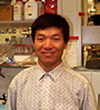|
Bacterium's Sticky Solution
 | |
| Jay Tang | |
A harmless bacterium that lives in waterways could be using nature's strongest adhesive, according to findings by US researchers. Bacteriologist Yves Brun of Indiana University Bloomington and Brown University physicist Jay Tang and colleagues have identified a natural chemical produced by Caulobacter crescentus and found it to be one of the strongest glues known. The material could theoretically be mass produced and used to coat surfaces for medical and engineering applications.
| |  |
| Yves Brun |
C. crescentus affixes itself to rocks in streams, rivers, and the interior of water pipes using a long, slender stalk - the end of which is dotted with chains of sugar molecules, polysaccharides. It is these incredibly sticky sugar chains that give C. crescentus its tenacity. Indeed, the researchers found that they had to apply a force of about 1 micronewton to remove a single bacterium from a glass pipette. That is 70 newtons per square millimeter or the equivalent of 8000 tonnes per square meter - three or four cars balanced on a quarter. In contrast, commercial "super" glue breaks with a shear force of just 20 or so newtons per square millimeter. "There are obvious applications since this adhesive works on wet surfaces," explains Brun, "One possibility would be as a biodegradable surgical adhesive."
 | |
"The challenge will be to produce large quantities of this glue without it sticking to everything that is used to produce it," Brun said. "Using special mutants, we can isolate the glue on glass surfaces. We tried washing the glue off. It didn't work."
Proc Natl Acad Sci, 2006, http://dx.doi.org/10.1073/pnas.0601705103
http://www.bio.indiana.edu/facultyresearch/faculty/Brun.html
http://biophysics.physics.brown.edu/
|

